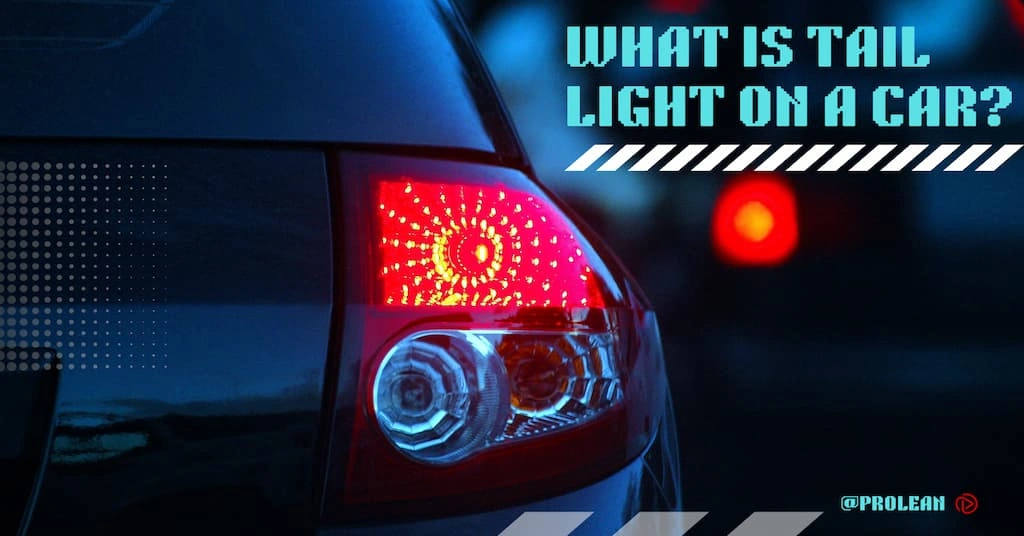
Tail light on a car explained
What is a taillight on a car? You can see them on the rear side of the vehicle. Not only the bulb or lightening strip, but the taillight also includes a complete shell cover assembly. This electrical component turns on along with the headlight and gives signals to other drivers on the road.
The use of the production right technology, choosing the right material, and creative customisations can significantly impact the performance and efficiency of taillights. At the same time, they provide aesthetic and road safety.
If you are looking for high-quality auto tail light covers, this article discusses all the nuances of taillights. The upcoming sections elaborate on types, manufacturing methods, materials, and how you can find the best manufacturer.
What Is a Taillight on A Car?

Tail light on a car
A tail light is a rear car component connected to the vehicle’s lighting system. You can find them on both the left and right sides of a car’s rear. The main function of tailight is to provide visibility to drivers behind your vehicle, especially in dark and dense fog weather.
Often, people confuse tail lights with brake lights because they both come inside a single physical assembly. But the car’s rear lamp glows with less intensity than brake lamps, and turns on while pressing the brake. Meanwhile, the taillights turn on along with the headlight, so they are also called car back headlights.
All of the above functions and characteristics conclude the answer to the question, “What is a tail light on a car?” in a simple sentence: It is a critical safety component in the car that provides visibility, easy parking, and aesthetic appeal.
Types of Tail Lights
There are different types of tail lights available in the market, each with a distinct lighting style and features. The type of tail light used in your car depends on its manufacturer and model.
They are classified based on their working mechanisms, design, and lighting pattern. Halogen, LED, Laser, fiber optics, and adaptive tail lights are the most common types.
Let’s discuss these in more detail.
Halogen Tail Light

Halogen tail light
This is the traditional type of tail light that uses a halogen gas-filled tube with a tungsten filament inside. When the power is supplied to the filament, it absorbs heat and glows brighter. Although this incandescent light is less durable, it is cheaper and utilizes simple technology.
The incandescent lights can be considered prominent Solutions for Classic and Vintage Car Parts. Although these are not used anymore in modern automobiles, they were popular back then.
LED Tail Lights
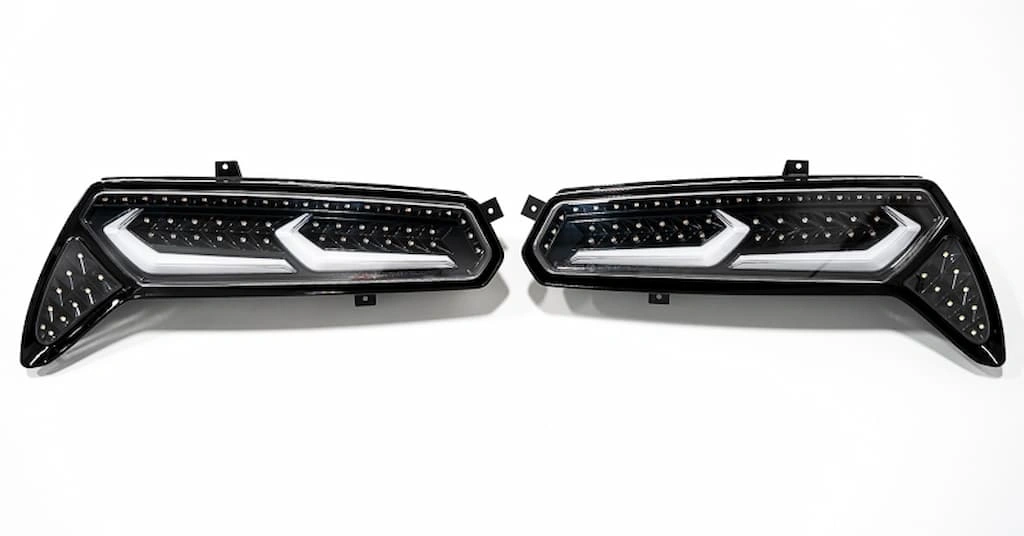
LED tail lights
LED means light-emitting diodes, an advanced lighting material that glows due to an electroluminescence mechanism when connected to the electrical power. These lights are more efficient and brighter, and also work for longer spans.
In today’s automotive industry, most companies put LED lights on back of car. They are sleek in design, have instant response time, and can be customized easily.
Fiber Optic Tail Lights
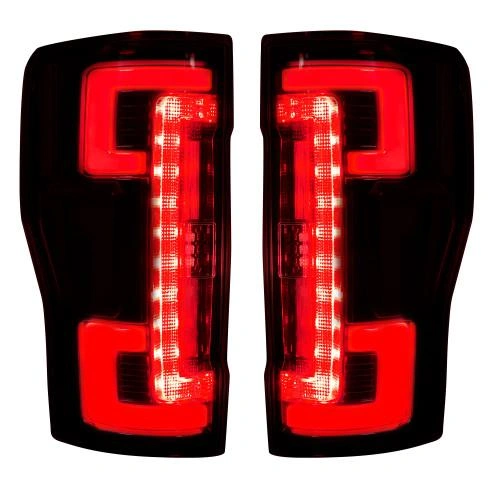
Fiber optic tail light
These types of tail lights are mainly used in modern luxury cars to improve aesthetic and uniform lighting. It uses an LED to emit the light, which is further carried and directed through a fiber-optic strand or rod, resulting in uniform and smooth lighting.
Fiber optic allows sleek and linear designs of tailight on a car; designers can choose light bars, continuous lines, and even custom shapes. You might see this on Mercedes and BMW, how they have sleek and distinctive signatures on their taillight designs. However, these are more expensive and also complex for installation.
Laser Tail Lights

laser taillight
Instead of light-emitting diodes, laser taillights use a laser diode as a source. Meanwhile, the concentrated laser beam gives a bright and sharp light after passing through the phosphor converter. Although it is not as common as LED, laser light technology can be seen in some high-end luxury cars. For example, Audi uses laser light in the tail to project the warning triangle sign.
Although being extremely bright and attractive, these are more expensive and not feasible to use in all cars due to strict regulations.
Adaptive Tail Lights
Adaptive means the lighting pattern can be changed according to the surroundings and weather conditions—for example, high intensity during fog and a specified pattern to signal something to fellow drivers behind.
Different sensors are used in this taillight to monitor the visibility, road conditions, and other parameters. Then, the light dynamically changes the pattern or light output accordingly. Meanwhile, LED or Fiber Optics are the primary lighting sources in this type.
Although adaptive tail lights on a car are more convenient and stylish, they need complex electrical wiring and are also more expensive than ordinary LED or laser.
Sequential Tail Lights
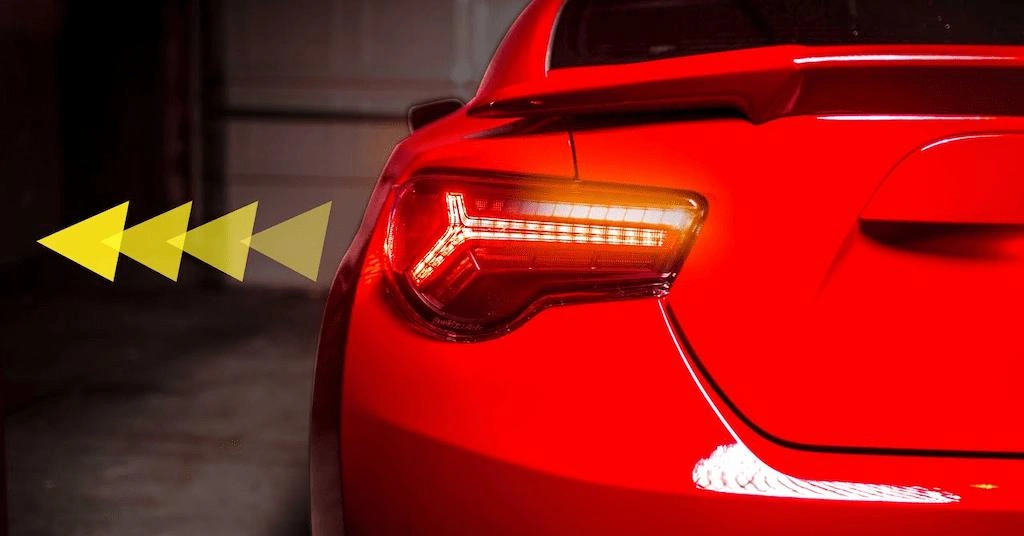
Sequential tailight
As the name suggests, this lights up in a pattern sequentially, providing clear signals and a stylish look to the car’s rear sides. An electronic controller in electrical wiring does this in a fixed time interval. The flowing sequential light provides quick attention to fellow motorists on the road, making it safer.
Try Prolean Now!
Materials for Tail Lights Manufacturing
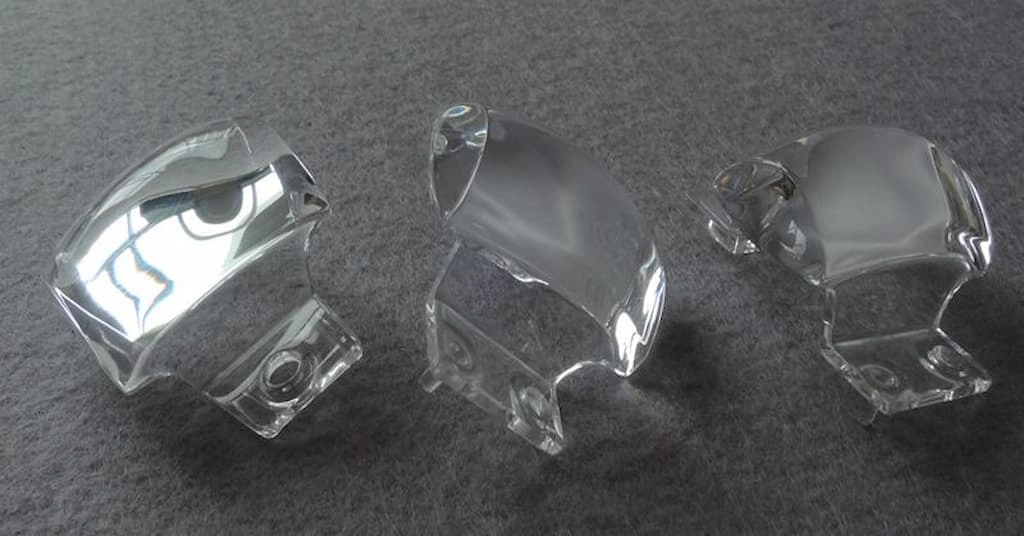
Taillight cover materials
Use of the right taillight material can only provide the desired lighting result, quality, and durability. For this, you must consider optical transparency, impact resistance, UV resistance, mechanical strength, and lightweight.
There are a few material options for the taillight, including Polycarbonate, Polypropylene, Acrylic, and ABS.
| Material | Key properties | Pros | Cons |
| Polycarbonate (PC) | Excellent impact strength, good heat resistance, UV/abrasion resistant. | Survives road stone hits, complex and thin-wall are possible, | Costlier than PMMA and prone to scratching and staining without coating. |
| PMMA (Acrylic) | Good transmittance, high clarity, UV-resistant. | Excellent clarity and good for light guides | Relatively brittle, requires care in handling, prone to scratches |
| Glass | High thermal/UV stability, excellent scratch resistance | Stable under high heat/flux LEDs and longer span. | Heavier and not suitable for exterior lenses of the tailight |
| Optical LSR | Optical grade, flexible, UV & thermal stability | It helps in sealing and is impact-tolerant | Risk of slight deformation |
| ABS | Good stiffness, surface finish, and cost-effectiveness | Cost/finish balance, good aesthetic quality. | Lower heat/impact vs PC-modified blends |
| Polypropylene (PP) | Lightweight, chemical resistance, and good moldability | Cost-effective, lightweight housings | Lower heat resistance and rigidity without compounding |
| PA6/PA66 | Thermal stability, good mechanical strength, and creep resistance. | Stable housings, and can sustain screws | Requires tooling control while manufacturing |
If you want to know further why material selection is crucial from designing to production and assembly, read Vehicle Design Principles And Process Explained. It governs functionality, surface texture, lifespan, aesthetic, and many other aspects.
Benefits of Upgrading Your Car’s Rear Lights
Whether you want to upgrade a lamp/bulb or complete a taillight assembly, it is always beneficial to have a new one. However, you might need to look at the rated power of the current light and the new light you want to replace it with.
Enhanced safety, customization, aesthetic appeal, energy efficiency, and longer lifespan are the main benefits of upgrading your rear lights. Let’s discuss each in brief.
-
- Improved Safety: New upgraded light increases the response time and makes the signals clear to fellow drivers on the road.
- Aesthetic & Luxury: Especially custom tailights give a sense of luxury and also enhance the aesthetic appeal. The upgrade also aids in the value of the car.
- Energy Efficiency: The LED lights consume less than 80% compared to traditional filament bulbs. This also reduces the heat generation from lightning.
- Durability: Advanced LED/ fiber optic lights are more durable than traditional lights. This provides seamless driving and reduces maintenance.
- Industry Compliances: New taillights comply with standards for visibility and colors of lights in cars, such as FMVSS 108 visibility in the U.S.
Common Tail Lights Manufacturing Methods
Understanding the process, benefits, and limitations of different manufacturing methods helps you to decide which method is best for your project. So, you can achieve optimal results at the best price regardless of production volume.
The popular methods available are injection molding, vacuum casting, CNC machining, and 3D Printing. Let’s elaborate on them shortly.
CNC Machining

CNC machined tail lights
Typically, 4, 5, or even higher axes CNC machines are used for tail light manufacturing, where tools remove the material from the work to craft the desired shape and finish. Techniques for tail light machining are milling, drilling, pocketing, etc.
CNC Machining Services are mainly suitable for research and development of taillights, like visual and functional testing prototypes. It delivers good results with intricate designs, maintaining accuracy and repeatability.
For precision taillight components, understanding all about CNC machining is crucial. This helps to ensure accurate dimensions, high durability, and consistency.
Injection Molding

Tail light injection molding
This is one of the most common methods to make tail lights of a car, as it offers excellent control over optical surfaces and can be produced in large volumes. This process involves creating a mold tool and injecting molten material like PC or PMMA into the mold cavity, which solidifies and captures the shape of the taillight.
The injection-molded taillights also go through hard-layer & UV-resistant coating to improve scratch resistance and impact strength. One major downside of injection molding is that it costs a lot for small-volume runs.
Vacuum Casting

Vacuum casted taillight
This method is suitable for 10 to 25 production cycles. Unlike injection molds, vacuum casting molds are made with silicone. For this, a master model (or pattern) is required, which is the exact replica of the desired tail light. The mold forms by pouring the liquid silicone over the pattern and removing it after solidification.
Vacuum casting has a low risk of gas porosity defects on molded parts. It also provides detailing and repeatability.
3D Printing
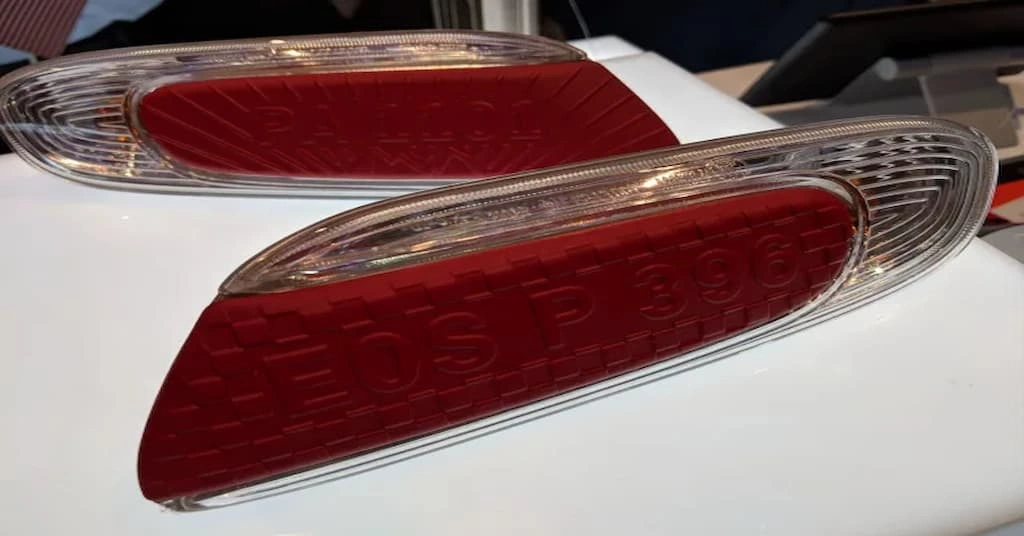
Custom taillight 3D printing
3D printing is an advanced method in tail light manufacturing, which builds the designed tail light layer by layer. Techniques like Stereolithography, Selective Laser Sintering (SLAS), and LSR 3D Printing are used for this.
Although large volume production is not suitable, you can choose 3D printing for rapid prototyping and testing design concepts. This method is also suitable for producing custom rear lights for cars because of its flexibility and quick turnaround.
Furthermore, if you compare top headlight manufacturing methods with methods for taillights, most of them are the same, including injection molding, machining, and vacuum casting.
DO you want to know more about the manufacturing of other automotive components? Click on the articles below and read them.
Try Prolean Now!
Difference Between Tail Light and Brake Light
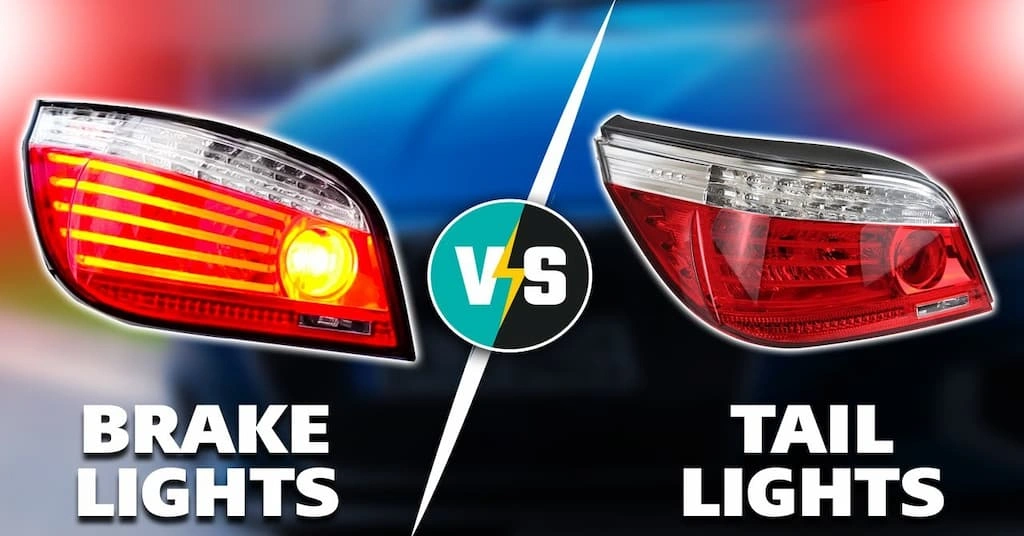
Brake light vs Tail light
In some cars, a single LED strip runs at different brightness levels, dimmer for the tail and brighter for the brake. On the other hand, some of the cars contain different bulbs/LED strips for them. However, both of them came inside a single assembly.

Brake light vs Tail light Detail Comparison
The difference between tail light and the brake light is that they light on with different brightness levels and are used to signal distinct messages. Taillight on a car provides the presence and width of the vehicle when headlights/parking lights are on, whereas brake lights turn on while pressing the brake pads and signal the stopping or slowing of the vehicle.
Let’s look at the differences in the table below;
| Criterion | Tail Light | Brake Light |
| Primary Function | Signals vehicle presence & width to others at night and in foggy weather. | Signal that the vehicle is slowing or stopping — an urgent “react now” message. |
| When does it turn on? | Turns on with parking/headlights or automatically by light/DRL logic. | Activates when the brake pedal is pressed. |
| Brightness | Lower intensity and visible without glare across all angles | High luminous intensity and a fast rise to full brightness |
| Optical Designs | Light guides/ diffusers are integrated to mark the outline/width, signature lighting. | concentrated strips for a clear visual |
| Safety Effect | Improves visibility but has less direct effect on crash avoidance compared to brake lights. | Lowers rear-end crash risk, provides clearer signals, and reduces stopping distance |
| Material | Generally, Acrylic or Polycarbonate | Same as taillight, but often red-dyed PC/PMMA. |
What Are the Causes of Tail Light Failure?
If your brake light and headlights are working but the taillights are not, it might be a case of failure. Checking the bulb/LED by replacing them and performing a continuity test in the electrical wiring helps to identify the failure.
Many factors can cause the issue of the tail lights not working or their failure, including bulb/LED, wiring harness, moisture inside the tailight assembly, and
- Bulb/LED issue: If the bulb is burned out or the LED strip is defective, the light stops working.
- Faulty Electrical Wiring: Any physical damage, corrosion, or alignment issues in electrical couplers interrupt the electricity flow required to light the tail bulb or LED.
- Worn-Out Tail Light Assembly: Any cracks in the assembly components allow moisture to enter, which can damage the internal parts.
- Taillight Fuse: Fuses protect electrical circuits in cars; a surge or short circuit can blow the fuse responsible for the taillights, disabling them entirely.
Tail Light Maintenance
Next, there are also some maintenance tasks to be done regularly to avoid any problems with the taillights of your car.
- Periodically inspect and replace the bulb/LED. You can check if they are dim or give uneven lighting.
- Clean debris, stains, and grime regularly and keep the light cover neat and clean.
- Check and tighten loose electrical connections and prevent any kind of damage or corrosion in the wiring harness.
How to Choose the Right Custom Tail Light Manufacturers?
Choosing the manufacturer that supplies custom taillights for cars requires careful consideration of different factors. You need to examine the supplier’s manufacturing capabilities, price structure, desired accuracy, design complexity, and lead time.
The list below has further elaboration of the selection criteria for how you can choose the best tail light manufacturer.
- In-house Manufacturing Capabilities
First, check the available equipment and technologies that manufacturers have. Then, verify they have all the desired capabilities, like mold making and surface finishing.
- Industry Regulatory Standards
Ensure that the manufacturer can produce tail lights of car, while maintaining industry regulatory standards, like FMVSS/ DOT for the U.S. and ECE/E-mark for Europe. Also, check quality standards like IATF 16949.
- Material Options for Taillight
Most of the manufacturers offer Acrylic and Polycarbonate, so ask your manufacturer what options they offer. The manufacturers must have the type of material you want to use for the taillight.
- Customization Flexibility
Is the manufacturer flexible in terms of customization of the tail light design with complex features? Also, ask about the adjustment of designs if you are ordering testing prototypes.
- Cost Consideration
Send your design to the short-listed custom tail light manufacturers and ask for quotes. Then, compare the pricing and lead time to determine which one can offer the best value for your money.
If you need optimal solutions for your car headlight project at competitive prices, ProleanTech can be Your Custom Parts Manufacturer. Whether rapid prototyping or large-scale manufacturing, we can make custom taillights for all types of cars.
We have Advanced technologies like multi-axis machining, injection molding, and 3D printing. Our engineers analyze the design and help you choose the best method.
Upload your custom taillight design and request a quote today!
Conclusion
Taillight is a crucial component that signals the presence and width of a car to following drivers on the road. Upgrading or customizing it not only improves safety but also improves aesthetic appeal. You can make them with injection molding or another suitable manufacturing method. Meanwhile, you can also order them from a secondary manufacturer.
Choosing the expert partner to customize the existing tail light or make a new one gives you the best results and a hassle-free experience. ProleanTech has experience in producing taillights for different automotive companies and individual suppliers. You can partner with us for quality taillights at competitive pricing and quick turnaround.
FAQs
How long do LED tail lights last?
An LED taillight can last for up to 10 years or 50,000 hours of operation. However, it depends on the weather you are driving, regular maintenance of the electrical system, and the quality of the light.
How much does a tail light cost to fix?
The total cost of fixing the taillight can be in the hundreds, including the labor charge. The exact cost depends on the brand and model of your car.
How to upgrade the brake light and taillight on a car?
It involves either replacing the bulb with an LED strip or a complete new assembly. For full upgrading, you might need wiring adapters or a CANbus module.

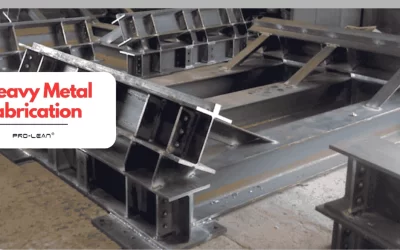
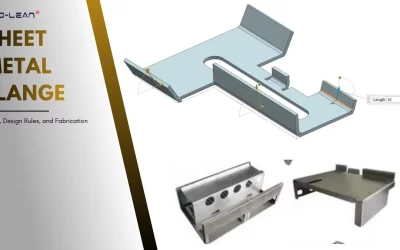
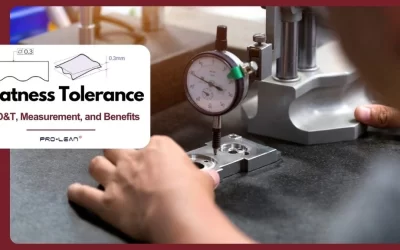
0 Comments